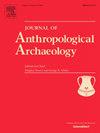谁造了奥尔当?回顾350万年前的非洲古人类化石和考古遗址
IF 2.2
1区 社会学
Q1 ANTHROPOLOGY
引用次数: 0
摘要
关于哪个非洲人族分类群负责生产奥尔多瓦石器的问题持续了近一个世纪。能人、boisei副人、直立人、南方古猿garhi和非洲南方古猿等被认为是候选物种,但我们从来没有一个明确的答案来回答“谁制造了Oldowan”。我们回顾了与Oldowan在时间上重叠的古人类分类群,并使用最优线性估计模型来估计每个分类群和Oldowan的首次和最后出现日期。这些模拟的时间趋势表明,奥尔多瓦人出现于约3.25 Ma,持续到1.6或1.2 Ma,这一时间跨度将使奥尔多瓦人成为最长寿的人类文化传统。人属的出现和早期人属的灭绝与奥尔多瓦人最早和最后出现的时间吻合得很好,但奥尔多瓦人与其他古人类类群,特别是傍人(Paranthropus boisei)之间也有相当大的时间重叠。在较短的模拟时间范围内(约3.25-1.6 Ma),人属的早期成员仍然是制造和使用Oldowan的主要候选者,如果Oldowan直到1.2 Ma才产生,那么P. boisei就是制造这些后期人工制品的主要候选者。本文章由计算机程序翻译,如有差异,请以英文原文为准。
Who made the Oldowan? Reviewing African hominin fossils and archaeological sites from 3.5 million years ago
The question of which African hominin taxon/taxa was responsible for producing Oldowan stone tools has persisted for nearly a century. Homo habilis, Paranthropus boisei, Homo erectus, Australopithecus garhi, and Australopithecus africanus, among others, have been proposed as candidates, but we have never had a definitive answer to ‘who made the Oldowan’. We review the hominin taxa that overlap temporally with the Oldowan, and use optimal linear estimation modeling to estimate first and last appearance dates for each taxon and the Oldowan. These modeled temporal trends suggest the Oldowan emerged c. 3.25 Ma lasting until either 1.6 or 1.2 Ma, a time span that would make the Oldowan the longest-lived human cultural tradition. The modeled emergence of the Homo genus and extinction of early Homo coincide well with the first and last appearance dates of the Oldowan, but there is also considerable temporal overlap between the Oldowan and other hominin taxa, particularly Paranthropus boisei. Early members of the Homo genus remain the principal candidate for making and using the Oldowan throughout its shorter modeled temporal range (c. 3.25–1.6 Ma), and, if the Oldowan was produced until 1.2 Ma, P. boisei is the prime candidate for producing these later artifacts.
求助全文
通过发布文献求助,成功后即可免费获取论文全文。
去求助
来源期刊

Journal of Anthropological Archaeology
Multiple-
CiteScore
4.00
自引率
11.10%
发文量
64
期刊介绍:
An innovative, international publication, the Journal of Anthropological Archaeology is devoted to the development of theory and, in a broad sense, methodology for the systematic and rigorous understanding of the organization, operation, and evolution of human societies. The discipline served by the journal is characterized by its goals and approach, not by geographical or temporal bounds. The data utilized or treated range from the earliest archaeological evidence for the emergence of human culture to historically documented societies and the contemporary observations of the ethnographer, ethnoarchaeologist, sociologist, or geographer. These subjects appear in the journal as examples of cultural organization, operation, and evolution, not as specific historical phenomena.
 求助内容:
求助内容: 应助结果提醒方式:
应助结果提醒方式:


